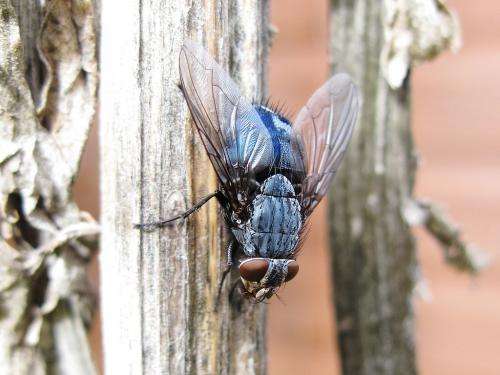Using blowflies as 'meth detectors'

The humble blowfly (Calliphora sp) could lead to better detection of methamphetamine (MA) in decomposing tissue.
A collaboration between the University of WA's Centre for Forensic Science and University of Turin's Department of Chemistry in Italy has explored the effect of MA on the development, growth rates and survival of the blowfly in relation to estimating post-mortem intervals.
The research involved developing and validating a gas chromatography–mass spectrometry (GC-MS) method to detect the MA in the blowflies.
"GC-MS is an 'old' chemistry method for the detection of different substances, especially drugs, and we adapted the technology," study author Dr Paolo Magni says.
"The validation process is very important in forensic science because any interpretation is evaluated in court.
"Insects, especially blowflies, are natural decomposers of the human body so if the cause of death was the use or abuse of MA—or other substances—we are going to find those substances in the insects that feed on the body.
"Any animal poisoned or drugged with pretty much anything can be used as a tool to detect such substances."
Determining time of death using insects can sometimes be more precise than the conventional method of looking at different stages of decomposition, which is largely contingent upon body heat.
In this study, experimental results found MA caused significant increases in the developmental time from blowfly egg to larvae.
About 60 per cent of larvae exposed to MA died during the pupation period. Larvae and pupae lengths were, on average, significantly longer than the controls.
Typical concentrations of MA found in human tissue after death from overdose were used.
Dr Magni, a member of UWA's Forensic Entomology Group (FEG), says the increase in developmental time should not necessarily be described as a "negative effect".
"It's just an effect that can be documented and utilised to determine that the human used MA and, as a consequence of using these measurements, we can determine a more accurate time since death," she says.
Among the FEG's primary research interests are insects and associated arthropods involved in the decomposition of humans and carcasses, factors determining the arrival of blowflies at corpses (often holding the key to post-mortem interval estimations) and time of death estimates for various law enforcement agencies for homicide and suspicious death cases.
A retrospective review of coronial files found MA has contributed to a clinically significant number of deaths in Australia, due to its cardiotoxicity and use in conjunction with other drugs.
More information: "Development of a GC-MS method for methamphetamine detection in Calliphora vomitoria L. (Diptera: Calliphoridae)." Magni PA, Pacini T, Pazzi M, Vincenti M, Dadour IR. Forensic Sci Int. 2014 May 20;241C:96-101. DOI: 10.1016/j.forsciint.2014.05.004. [Epub ahead of print]
Provided by Science Network WA

















